Australia So Much to See


The Gibb River Road West Kimberley 2008 - we continue along the Gibb River Road and visiting various features and waterfalls.
A number of stations provide accommodation and camping facilities, and allow access to selected gorges on their pastoral leases. We chose to visit Charnley River Station (previously known as
Since our visit the Charnely River Station has been purchased by the CEO of Australian Wildlife Conservancy which owns Mornington Wildlife Sanctuary. Camping and bunkhouse accommodation remains, but prices have risen. Pastoral activities are being scaled down.
There are numerous river and creek crossings along the
The native deciduous Kurrajong trees were covered in bright red flowers known locally as Kimberley Rose.
Dillie Gorge has a lovely big pool for swimming, fed by small cascades. It is quite a drive there on station tracks, so you may have the beauty of this wide pool all to yourself.
Some way further along station tracks is Grevillea Gorge, where a slippery waterfall tumbles down large steps into a green pool framed by orange brick like walls. To get down into the gorge at the top of the waterfall involves a climb down a ladder. We did not attempt to climb down the large and slippery steps that comprise the waterfall.
Lovely Galvans Gorge features a boab tree right on the top.
This pretty pool on the way has water lilies and reflections of wildflowers.
Climbing into the gorge itself is a bit tricky, and involves crossing the top of a small waterfall past prickly leaved spiral pandanus. Not so many people come to Adcock Gorge, so it is nice to enjoy a swim in such lovely seclusion.
Visiting just these these two gorges was a 98 kilometre round trip on the station tracks which involved three hours driving; even
slower when wildlife such as this Bustard take their time on the tracks.
One hundred kilometres from the
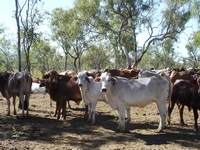
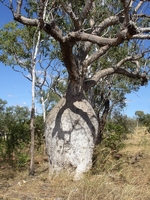
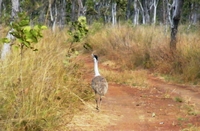
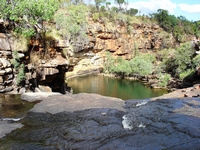
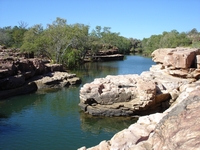
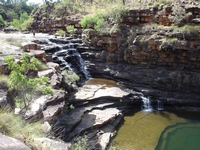
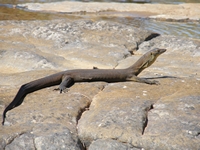
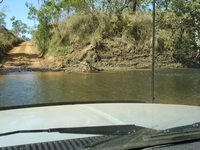
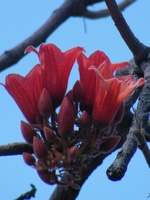
Looking onto the pool from the top of the falls with water rushing down.
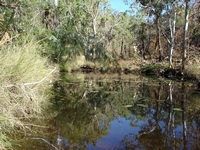
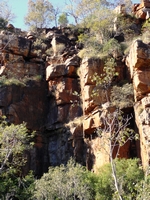
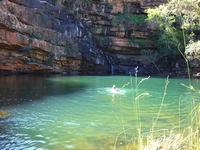
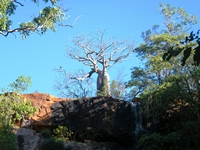
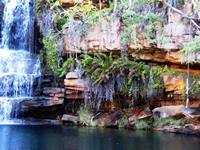

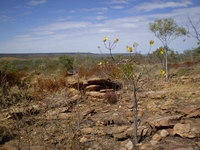
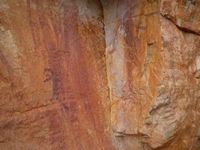
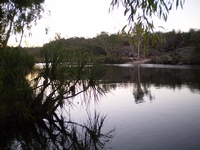
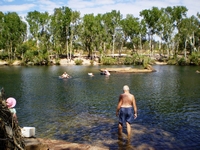
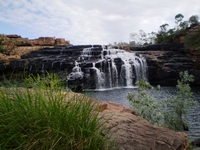
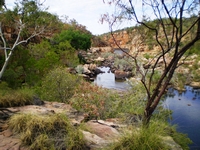
Campground has solar heated
showers plus toilets. $10 fee camping fee $15 per person per night 2023.
At dusk, I checked out
where we were going to cross the
Near the falls, is a face with Aboriginal rock painting. This was the first time we saw ancient Bradshaw paintings, with later
paintings over the top of them. We saw this combination many more times in the
It was a rather cool and cloudy in the morning when I swam across to bring back as many boxes
as I could for ourselves and others waiting.
The two kilometre walk across a ridge to the Upper Manning Gorge was very pleasant, particularly in the mild weather. We looked
across a vista of vast Kimberley plains and a range in the distance. The yellow flowering shrub is known locally as wild kapok,
and grows throughout the
Looking downstream as the river came into view again.
On our return to river crossing, people were still heading in both directions across the river. There is a small rocky island in the centre of the river, and the following day, as swimmers made their way across on the return from the Falls, a Johnston (freshwater) crocodile was basking on the rock, giving way to no-one.
Soon after this, we left the
This patch on the
The track into Barnett River Gorge was not an easy one, and the gorge not a spectacular as others, so if pushed for time, this would
be the one to miss.
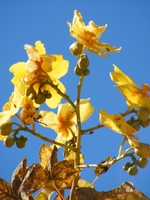
We started out walking with others, following little stone
We continued along the top of the gorge, heading upstream for quite some time and distance, before finding a path that finally led
us down to the river way below, at a point where the gorge cutting was ending and the river valley was becoming wider and shallower.
Cooling down in the fast flowing shallow cascades, tiny red finned fish nibbled our knees. After all that walking, the cool
waters were refreshing, even if not dep enough for swimming. We returned, without finding out how to get to the big pool where
the tour group had been.
Australian Wildlife Conservancy manages a very large area of land in the Kimberley.
Tableland Wildlife Sanctuary,
covering 308,000 hectares of the remote central Kimberley, became an AWC sanctuary in 2012. Adjacent to Mornington-Marion Downs,
the three properties combined represent a contiguous protected area of more than 870,000 hectares (over 2.1 million acres).
Charnley
River-Artesian Range has a vital role to play in protecting and restoring the endangered wildlife of northern Australia. The Artesian
Range is located adjacent to the Kimberley coast, in the heart of one of Australia’s most rugged and inaccessible regions. Covering
173,000 hectares,
The Yampi Sound Training Area is an area of outstanding conservation value. In a remote corner of the west
Kimberley lies a vast property that has been virtually untouched for almost 50 years. Covering 568,000 hectares, including over
700 kilometres of coastline, Yampi is a hotspot for endangered and endemic wildlife. AWC has been contracted by Defence to deliver
science-based land management at Yampi. Our ground-breaking partnership with the military will deliver effective conservation for
one of Australia’s great natural treasures.